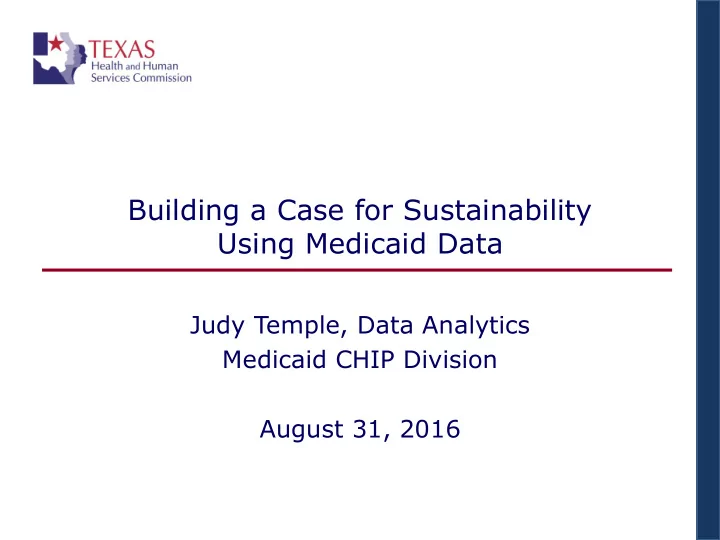

Building a Case for Sustainability Using Medicaid Data Judy Temple, Data Analytics Medicaid CHIP Division August 31, 2016
Project Background Transition Medicine Clinic (TMC) has been a DSRIP project • under the 1115 Transformation Waiver since SFY12 Provides a transitional medical home to young adults with • chronic childhood conditions Provides additional social services not typically covered by • public and private insurers 2
Evaluation Background TMC is building a case for value-based purchasing with • evidence of positive health outcomes One of the project’s stated goals is to reduce Emergency • Department utilization by 25% Since a high proportion of TMC clients receive Medicaid, • Data Analytics is using Medicaid enrollment, claims, and encounter data to measure TMC client ED utilization 3
Method TMC provided Medicaid IDs, first and last TMC visits, and • diagnoses Define study group • • 18 months continuous enrollment during SFY10-SFY15 Create comparison group • • Enrollment data to identify similar clients • Propensity score matching Identify ED visits in claims and conduct analysis • Average monthly visits • Pre-post design • 4
Study group characteristics 5
Comparison Group Clinical programs not usually set up for experimental design • Without randomized control group, more difficult to • attribute any change in outcomes to program intervention Data provides opportunity to construct comparison group • First step: identify clients from data with a set of • characteristics found in the study group. Age, service area, and Medicaid program type • 6
Before Matching: Study and Comparison Group Characteristics 7
Comparison Group, cont. Propensity score matching: • Ensures that the distribution of client characteristics is similar • Generates a score for each treatment and potential comparison group • subject based on client characteristics Clients are matched by most similar score • Matched variables include: • Gender • Race • Age • Program Type • Risk Group • ICD code • Fiscal Year of first TMC visit • Number of ED visits in 6 months before TMC • 8
After Matching: Study and Comparison Group Characteristics 9
Study Period Design Period 1: Period 2: Period 3: 6 month period 1 st 6 months 2nd 6 months pre TMC visit post TMC visit post TMC visit MONTHS 1-6 MONTHS 13-18 MONTHS 7-12 18 MONTHS 10
Average Monthly ED Visits per 1,000 Clients: TMC and Matched Comparison Group First TMC visit 140 ED visits per 1,000 clients 120 100 80 60 40 20 0 Month in study period Period 1: 6 months pre TMC Period 2: 1st 6 mths post TMC Period 3: 2nd 6 mths post TMC Comparison TMC 11
Study and Matched Comparison Group: Total Visits by 6 Month Period Period 1: 6 mths pre TMC Period 2: 1st 6 mths post TMC Period 3: 2nd 6 mths post TMC 158 131 118 105 78 70 STUDY COMPARISON PERCENT CHANGES AND P VALUES STUDY GROUP Period 1 to 2 -26% p = .099 Period 1 to 3 -33% p = .019 Significant at 95% CI, 5% margin of error COMPARISON GROUP Period 1 to 2 -25% p = .055 Period 1 to 3 -17% p = .270 12
SUMMARY Preliminary Findings: ED visits for TMC clients decreased by over 25%, their desired • outcome ED visits for both groups decreased from Period 1 to Period 2 • The decrease for TMC clients was statistically significant from • Period 1 to Period 3 Next steps: Add more quarters of ED data as available • Refine comparison group • Regression analysis to clarify major contributors to decrease • 13
Recommend
More recommend